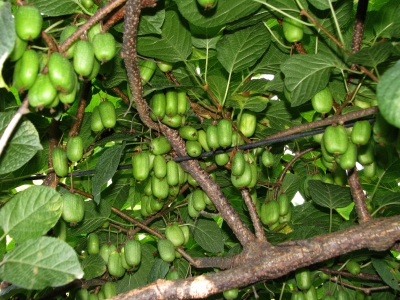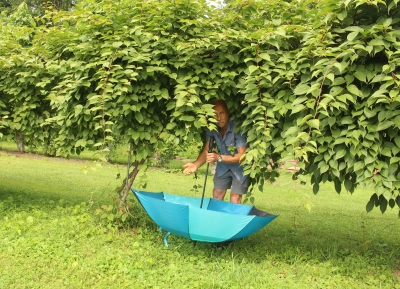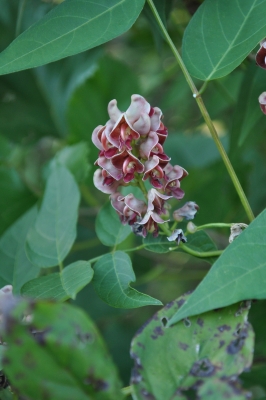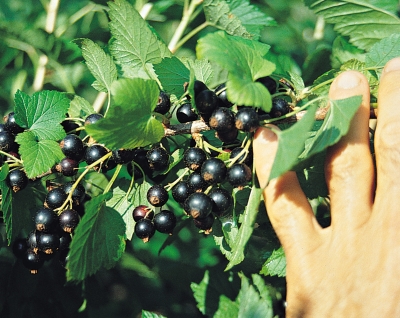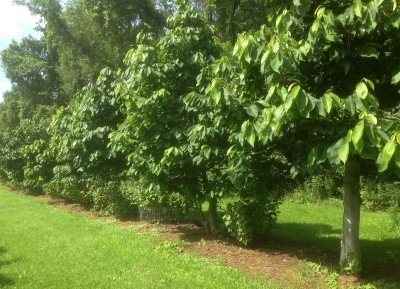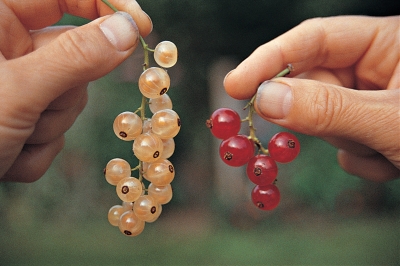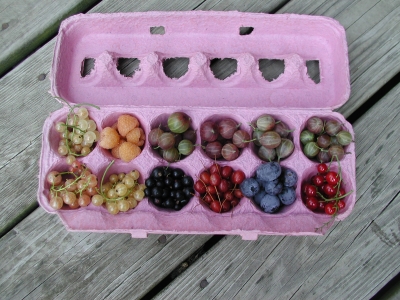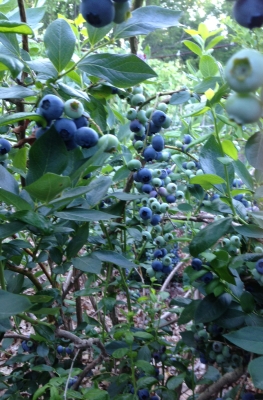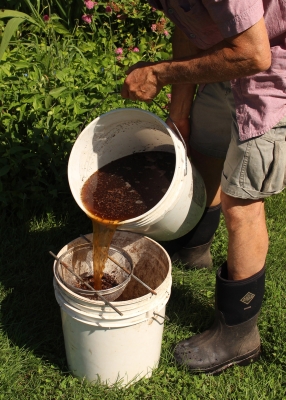DUCKS WORKING, BUT NOT ON GROUNDNUTS
/9 Comments/in Fruit, Gardening, Pests, Vegetables/by Lee ReichTHE DUCKS CALL THIS “WORK”?
My ducks told me that the hardy kiwifruits were ripe. No, they’re not trained to give a specialized “hardy kiwifruit ripe” quack. Instead, they’ve taken to hanging out beneath the vines to scoop up dropped fruits. No training needed for this.
Those dropped fruits are one reason that these vines — Actinidia kolomikta — are not as popular for fruit as another species, Actinidia arguta. Ripening, and dropping, is fast in the heat of July. Arguta kiwis ripen in late summer and early fall, and possibly cling to the vines more reliably then because cooler weather slows ripening.
Not that either of the fruits are well known. Both are cousins to the fuzzy kiwis (A. deliciosa), ubiquitous in supermarkets. Both hardy kiwis differ from the fuzzies in being cold-hardy (only to 0°F for the fuzzy as compared to minus 30°F for A. arguta and to minus 40°F for A. kolomikta), grape-sized, with smooth, edible skins, and better flavor than the fuzzies.
In addition to ripening earlier and dropping more readily, kolomikta kiwis differ from arguta kiwis in coming into bearing much sooner, often in their second year, and growing much less rampantly. Argutas are hard vines to tame. Ornamental vines of both species gracing historic gardens for decades before their fruits were noticed and appreciated is testimonial to their beauty. Kolomikta’s leaves are brushed silvery white with random pink blushes.
Back to harvest. Harvest from the ground is unfeasible because the green fruits are too hard to find among the blades of green grass. And unhealthy because of all the processed kiwifruits — poop — the ducks eject at their far end as they gobble up the berries. A ground cloth to catch the berries would become similarly soiled unless I went to the trouble of spreading it, shaking the vines, then gathering up the cloth after gathering up the fruits.
Instead, I’ve taken to walking beneath the vines with a large umbrella, upturned, and shaking portions of the vines right above the umbrella. Ripe fruit drop into the waiting “funnel.” Sure, many fruits are lost, but the vine bears more than enough to share with the ducks, who can enjoy the missed fruits.
RIPENING OFF THE VINE, HOW CONVENIENT
Like apples, bananas, and avocados, kiwifruits of all stripes are climacteric fruits. Instead of steady ripening, climacteric fruits, just before they are ready to eat, go through a burst of ripening with sugar levels and carbon dioxide production all of a sudden rapidly increasing. Fruit quality begins to decline right after this burst.
Ethylene, a simple gas that is also a naturally occurring plant hormone, also spikes during this burst. And ethylene further accelerates ripening, which increases ethylene production even more, which increases ripening even more, and . . . Disease, wounds, and decay also stimulate ethylene production, which is why “one rotten apple spoils the barrel.”
If picked when sufficiently mature, but not dead ripe, kiwifruits store well for a few weeks. They’ll ripen during storage, slower under refrigeration, faster at room temperature. From experience, I know that “sufficiently mature” for kiwis is when the first fruits start ripening. So, in addition to my umbrella harvesting, I’m harvesting a bunch of the unripe fruits and refrigerating them to extend their season. Don’t worry; there’ll still be plenty for the ducks.
SOMETHING FOR YOU PERMACULTURALISTS
Every time I walk back to the kiwi vines, I pass a perennial flower bed. Or, at least, what was supposed to be a flower bed and now is bordering on half flowers and half weeds. The major two weeds, I admit, are my own doing.
The first of these weeds is dayflower, which arrived here with some bee balm plants from a friend. It’s actually a pretty plant with small, blue flowers, and it’s easy and satisfying to pull out. To a point.
The other weed, groundnut, was a deliberate planting, by me, about 20 years ago. It seemed interesting, bearing edible, golf-ball-sized tubers that string along underground like beads. Groundnut reputedly is the food that got the pilgrim’s through their first winter. Occasionally the plant, a vine, flowers, bearing chains of pale chocolate-colored blossoms. Do I remember them smelling like chocolate also? Perhaps. With all the other vegetation in the bed, the plants haven’t flowered in a long time.
The problem is that those chains of tubers spread to make more chains of tubers which, in turn, do likewise, ad infinitum. The vines now creep over almost every plant in that bed but rarely get enough space to themselves to make tubers anymore. No matter. They didn’t taste that good anyway.
I wasn’t as foolish as might seem planting groundnut in that flower bed. Twenty years ago that flower bed wasn’t a flower bed, but just a place for interesting plants in my then small garden.
SO MANY FRUITS, SO LITTLE . . . ?
/5 Comments/in Books, Fruit, Gardening/by Lee ReichHow Can Something So Nutritious Taste So Good?
Black currants are a berry brimming with vitamin C (in comparison, oranges are like water) and other health goodies, with an intense, rich, to me resin-y flavor that pairs well with dark chocolate or, on bread, with peanut or any other nut butter. Not everyone enjoys the fresh flavor, but that’s okay. Not everyone needs to enjoy every kind of fruit.
What the doyen of horticulture, Liberty Hyde Bailey, wrote almost 100 years ago about apple varieties also applies to fruits in general: “Why do we need so many kinds of [fruits]? Because there are so many folks. A person has a right to gratify his legitimate tastes . . . There is merit in variety itself.”
With that said, just about everyone does like black currants once they’ve been cooked and sweetened to make jam, juice, pie, and the like, or soaked in alcohol to make a liqueur (créme de cassis). My preference is for the raw berries, eaten straight up, in my cereal, or smooshed on bread as an instant jam.
Black currants have more to recommend them than only good flavor. In contrast to most fruit plants, they fruit well in shade. Look down my row of pawpaw trees, and in the shade between every two of them you’ll see a black currant bush thriving. In contrast to just about every other plant, black currants are deer resistant. My ducks and chickens, as well as wild birds, leave the berries alone.
In fact, few significant pests attack the plant or the fruit — except for a disease called white pine blister rust. This disease needs two different host plants to complete its life cycle, a susceptible variety of currant or gooseberry, and a white pine. Because the disease can kill white pines, an important timber crop, gooseberries and currants were once banned by federal law. That’s no longer the case, one reason being that most cultivated varieties of gooseberries and currents are not very susceptible to the disease.
Black currant is very susceptible to the blister rust disease — except for some rust-resistant or immune varieties. The first of these, Consort, Crusader, and Coronet, developed in the middle of the 20th century, were not very tasty just popped into your mouth raw. Newer rust-resistant varieties, such as Belaruskaja and Titania, are delicious any which way, and along with blueberry are my favorite fruits.
Bye, Bye, Black Currants
Sad to say, black currants are finished for the season. That’s their one deficiency: They come and go too quickly. Still, bags stuffed full of black currants are now in the freezer, not to be opened until Christmas.
And I can’t complain. Branches of blueberry bushes are bowed to the ground under their weight of fruit, and will continue to do so until almost the end of summer. And gooseberries still have a a week or so more of fruiting. Mulberries, too, have a few more weeks, except that the birds are eating most of them.
Red, pink, and white currants started fruiting with the black currants, and will hang in good eating condition for weeks to come. Red, pink, and white currants are different varieties of the same fruit (like Red Delicious and Golden Delicious apples), a different species and quite different in flavor and bearing habit from black currants. Most of the reds, whites, and pinks will hang from the branches for weeks because the berries, looking like shiny, translucent chains of beads, the seeds visible seemingly floating within when backlit by the sun, are almost too pretty to harvest. Also, not being my favorite fruits, they get to hang without being picked, especially with the abundance of other, tastier (to me), berries, an opinion that might change if I had some skill in jelly-making.
I’m an Amateur, for Sure
Liberty Hyde Bailey would be proud of the abundance and variety of fruit here. That’s one great advantage of planting your own: You get to choose what pleases your palate as far as kinds of fruits and varieties of fruits, and you get a hedge against a poor harvest from one or a couple of fruits any year. Hence the Macoun and Hudson’s Golden Gem apples here, the grapes, and gooseberries (a dozen varieties of each), gumis, raspberries, kiwis, seaberries, and elderberries, among many other fruits.
Again, quoting Liberty Hyde Bailey: “We give the public indifferent fruits, and thereby neither educate the taste nor stimulate the desire for more . . . Just now [1922] we are trying to increase the consumption of apples . . . it cannot be accomplished by customary commercial methods. To eat an apple a day is a question of affections and emotions.”
Professor Bailey had great faith in the role of the hobbyist, the amateur (in the true meaning of the word, the lover) in fruit growing. Try it.
One route to cultivating a greater appreciation for fruit and know-how for growing them is to join North American Fruit Explorers, a band of fruit “nuts” drawn from both academia and backyards, but all amateurs. For more information about some lesser know fruits, including black currant, I recommend my own book, Uncommon Fruits for Every Garden.
BLUEBERRIES GALORE, COMPOST TEA REDUX
/19 Comments/in Fruit, Gardening, Soil, Vegetables/by Lee ReichOn My Knees for Blueberries
For the last few years, my blueberries have had a problem. Perhaps yours also. Rather than grow upright, the stems arch downward, some so drastically that they actually rest on the ground.
A few years ago, I pinned blame on the weather. Not that it was evident just how the weather could be responsible, but it’s always convenient, in gardening, to blame things on the weather. But this explanation is hardly convincing. Spring and summer weather have not been consistent enough over the years to be able point my finger at too much rain and/or not enough sunlight (the combination of which could lead to those bowing branches).
How about pruning or fertilization? Too much of either could promote lush growth that couldn’t support itself. Except that my pruning has been consistent over many years. And Dr. Marvin Pritts, berry specialist at Cornell, confirmed that he and others saw the same problem, without definitive explanation, a couple of years ago.
I like the green thumb explanation best: That is, that I’m such a good blueberry grower that the branches can hardly support the prodigious crops I’ve coaxed from them. So I’m not really complaining. Just curious. And having to get on my knees to harvest low hanging fruit.
Remember Fruit Flies?
There is one fly in the green thumb ointment. A fly, literately. A tiny fruit fly called the spotted wing drosophila or, quicker to say, which is necessary for this fly that’s getting a lot of buzz lately, SWD. The fly attacks many small fruit, starting the season with honeysuckle berries, then moving on to raspberries, blackberries, and . . . blueberries.
Most fruit flies lay their eggs in overripe, or at least ripe fruit. Not SWD. She lays her eggs in unripe fruit. The eggs are small and what hatches from them are small; their being “maggots” sort of takes the appeal from the berries.
SWD is a new pest, so new ways of thwarting them are being tried. Covering the plants with fine netting very early in the season is effective but would be very bothersome, for my planting, at least. Various organic sprays are another possibility: Entrust, which is derived from a soil bacterium, is effective if used STRICTLY according to directions; horticultural oil might prove effective. Traps are also under test.
One way to bypass the problem is to grow only earlier varieties of blueberries. SWD has not showed up here and at many other sites until early August. Plenty of varieties — Duke, Earliblue, Toro, and Blueray, for example — are finished before then.
But I want fresh blueberries on into September. Harvesting blueberries (or raspberries or other berries) and whisking them into a refrigerator at 34 degrees for 72 hours will kill eggs and larvae. Freezing, the destiny of about half our harvest, also kills the eggs and any hatched larvae. A little egg and meat boosts the protein content of the berries.
I Backpedal, Sort Of
It may be time for me to eat pie. Not blueberry pie, but humble pie. Regular readers of my words probably realize that I take a certain amount of pleasure in iconoclasm. And one recipient of my eye-rolling has been compost tea, something that many gardeners and farmers love to love even though there’s little theoretical or empirical support for its efficacy.
“Little” but not “none.” A number of peer-reviewed articles describe benefits from using NON-AERATED compost tea to thwart root diseases. (The relatively recent interest in compost tea is for AERATED compost tea, often sprayed on leaves. Aerated compost tea, the brainchild and business of Dr. Elaine Ingham, is compost tea that’s bubbled with air for en extended period, often with molasses or other additions. Generally, experiments have not supported touted benefits of aerated compost tea.)
For the past number of years, my pea crops have been failures, the plants yellowing and dying soon after harvest begins. Fusarium or some other root disease is the probable cause.
In desperation, five times this spring, at about weekly intervals, I put a shovelful of compost into a 5 gallon bucket and filled the bucket with water. After one day of steeping, the tea was strained, put it into a watering can, and drenched on the soil beneath of my thirty foot, double rows of peas.
Lo and behold: The peas look healthy and have been yielding good crops!
I won’t say for sure it was the compost tea or what in the tea, if it was the tea, did the trick. But nothing else jumps out this year as the savior of my peas. For a more definitive tea endorsement, next year I should grow a row or two without the tea, and a row or two with the tea. I might try that, although it presents the possibility of my ending up with a row or two of unproductive vines.
For now, I’ll just have humble pie. And tea.

